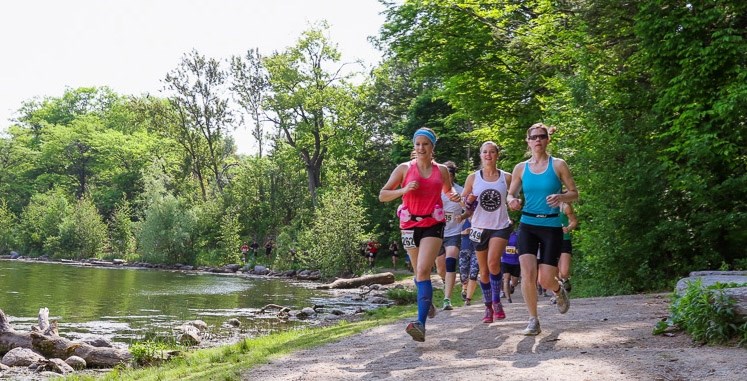Running conjures up a lot images. Early mornings sunrise; the flash of neon windbreakers; someone looking the wrong way who’s about hit a pole; really, really angry drivers; the list goes on.
But what about trail running? Well, there’s no great mystery there. Trail running is basically that – you’re running on this good green earth, instead of boring, unforgiving pavement. And, if you’re a runner in Cochrane with any interest in trail running, you’re in the right place, according to Amy Golumbia.
Golumbia is a national- and international-level trail runner and CEO of Calgary-based 5 Peaks Adventures Ltd., which organizes different trail running programs and races throughout the year. She started racing with 5 Peaks when she was 15 and has since won the national mountain running championships in 2009, completed over ten 50 km races, the 180 km Trans Rockies run twice and has competed at the World Mountain Running Championships twice as well.
She spoke with the Eagle via email about some things to consider if you’re tired of dodging traffic.
“When you first switch from road to trail running, make sure you are aware and paying attention to footing at all times,” Golumbia says.
Unlike the predictable pavement, trails can vary greatly, “from double track logging roads, to single track trails through the forest, to rugged hiking trails.” They can change and offer all manner of features.
The most important things, Golumbia said, are knowing the distance of the trail and letting someone know where you’re headed so you don’t become search and rescue scenario or worse, a recovery mission. Better yet, bring a buddy. And some advice for the quantified road runner obsessed with keeping times?
“Don't worry too much about your pace, as it will vary with the steepness and technicality of the trail.”
Three words: “watch your feet.” There’s all manner of nasty (and fun) obstacles you’ll encounter that aren’t found on the road – fallen logs, sharp rocks, brambles, streams, the odd hole. Golumbia says simply lifting your feet as opposed to the “runner’s shuffle” that develops from running on pavement. Again she pointed to slowing your pace, since it’s more technical rather than lateral.
“You could go from an eight-minute mile pace on the road, to over 11 minutes per mile on the trail, and this is perfectly acceptable and recommended.”
You may have seen trail runners and notice that they’re similar to soccer cleats. That’s because, unlike road runners, these guys have “teeth” or tread designed to grip looser surfaces. They’re also built with greater toe protection to safeguard against breaking a toe(s) against rocks and roots.
However Golumbia stressed there’s no need rushing out to buy a pair.
“Go in your road shoes for the first little while until you get the hang of trail running, and then go to a very knowledgeable running store so that the staff can help you find an ideal trail shoe.” At upwards of $100 or more, they’re bit of an investment, so be mindful of what you’re thinking of buying.
Unsurprising, Golumbia said the main danger is getting lost. She recommends carrying a phone (a charged phone) and again, a friend – someone who knows the area or trail well. Another great items to include, especially if you’re on a hiking trail, is a backpack loaded water, food and a basic first aid kit. If you’re heading deeper into the backcountry, Golumbia says to obey all wilderness rules as well as make lots of noise and keep your headphones out. She also recommends carrying bear spray. Because, you know, bears.
“We see so many benefits to adding trail running into your normal running routine. Not only do you get peace and quiet away from all the traffic and city noise, but you get to spend time in nature, breathing fresh air and traveling in a self propelled and natural manner, to beautiful places,” she says.
Golumbia pointed to a number of studies that discussed the advantages to spending time in nature: lowered blood pressure and stress levels, increased natural killer cells, decreased cortisol production (stress hormone), and a general feeling of tranquility and peace.
“It is especially beneficial for children, and for families, to spend time out there together.”
She says that trail running can also benefit the body more than road running.
“Not only do you avoid the impact of running on pavement, but you strengthen many other muscles in the body that wouldn't otherwise be used in the same repetitive motion of road running.” So instead of striking the same even surface again and again, your body has to adapt to a mixed offering of different terrain.
She says her organization also finds that a lot of people who suffer from overuse injuries sustained from the road find great relief on trails.
“A great place to start trail running near Cochrane is the Glenbow Ranch Provincial Park, just outside of town. It is absolutely spectacular and not overly technical. Another option is the trails near the Ranch House. If you're willing to drive to Canmore, there are great maps and trails at the Nordic Centre and around the Quarry Lake. You can also see the maps on our websites for any of our five races, and try one of them out for fun. But there are literally trails everywhere and it is so fun to go exploring!”



